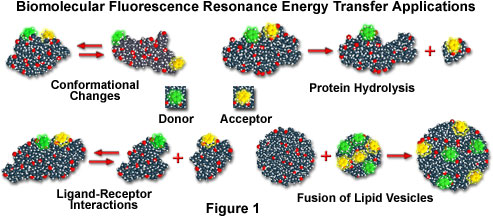A wide spectrum of living organisms are capable of emitting light through biochemical mechanisms, including the firefly, jellyfish and certain bacteria. Some of these organisms emit light by absorbing specific wavelengths light, while others emit light by consuming energy stored within the body.
Fluorescent proteins emit fluorescence by absorbing and re-radiating the energy of light. Jellyfish, coral, sea anemones and certain bacteria have such proteins within their bodies. On the other hand, bioluminescence originates from a chemical reaction inside the body; examples include the firefly and species of the Noctiluca genus. The light-emitting substance is either located inside the cells (the firefly and Noctiluca) or secreted to the exterior (Cypridinacea). Although proteins are involved in these chemical reactions, the proteins themselves do not emit light directly.

Both fluorescent proteins and bioluminescence are widely used in medical and biological research applications. Thousands of materials have been collected from the field. While only small amounts of the proteins have been extracted in such studies, the proteins have been made available through chemical synthesis or genetic engineering. The genes of the green fluorescent protein (GFP) and its variants are available commercially and are applied in the fields of cell biology and molecular biology.
Fluorescent Proteins
- Green Fluorescent Proteins and Variants: BFP, CFP, GFP, YFP, and DsRedFP
- Phycobiliproteins: B-Phycoerythrin (B-PE), R-Phycoerythrin (R-PE), and Allophycocyanin (APC)
The GFP occurs naturally in jellyfish; amino acids in the 65th to 67th positions have been found to emit fluorescence by ultraviolet or blue light excitation (DsRed is found in the sea anemone). The GFP gene is used in research to visualize or track activity at the cellular level through its expression in cells.
The phycobiliproteins are obtained from bacteria and algae. These proteins contain a covalently linked fluorescence group. Specimens labeled with phycobiliproteins are used mainly for flow cytometry and can also be observed in microscopy.
Excitation and Emission Characteristics
of Fluorescent Proteins
| Fluorescent Protein | Excitation Wavelength (nm) | Emission Wavelength (nm) |
|---|---|---|
| GFPwt (Wild Type) | 395/475 | 510 |
| ECFP | 433 | 475 |
| EGFP | 488 | 507 |
| EYFP | 513 | 527 |
| DsRed | 558 | 583 |
| B-PE | 545/565 | 575 |
| R-PE | 410/545/565 | 578 |
| APC | 650 | 660 |
Table 1
Bioluminescent Proteins
- Aequorin
- Luciferin-Luciferase
Among the bioluminescent proteins, aequorin and luciferin are the two types most frequently used in biological research. Aequorin is a bioluminescent protein complex isolated from the jellyfish and used in calcium ion concentration measurement. It includes the protein apoaequorin and a latently luminescent molecule. When a calcium ion binds to aequorin, the complex breaks down into apoaequorin and a luminescent molecule, which emits blue light (approximately 466 nanometers). Unlike measurements using the fluorescent dye probes, calcium ion concentration measurements using aequorin do not require excitation and are not affected by autofluorescence. Synthetic apoaequorin is currently available from several sources. The apoaequorin gene can also be used in calcium ion concentration measurement through its expression in mitochondria.
Luciferin is the bioluminescent molecule obtained from the firefly; it emits luminescent light when it is oxidized by an enzyme (protein) named luciferase (wavelength up to 560 nanometers). As ATP is indispensable in the Luciferin-Luciferase reaction of the firefly, this reaction is used for an ATP detection kit with very high sensitivity. Such ATP detection kits are available commercially. The luciferase gene has also been isolated and can be expressed inside cells.
Internet Resources
- The Bioluminescence Web Site - Reliable information on marine bioluminescence is widely scattered in the literature and in unpublished data. While this is merely an inconvenience to the relatively small core of investigators actively working in the discipline, there is a much larger group of life scientists, oceanographers and applied marine scientists who frequently come upon problems involving bioluminescence and who might have little awareness of the availability and reliability of information on the subject. This website is targeted that increasing the awareness of bioluminescent proteins.
- Bioluminescence and Biological Fluorescence - This useful website provides a series of links to many of the important Internet resources dealing with the phenomena of bioluminescence and fluorescent proteins. The site is hosted by herper.com, an organization dedicated to the study of invertebrates, reptiles, and amphibians.